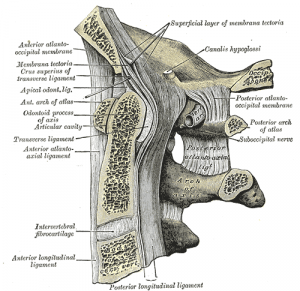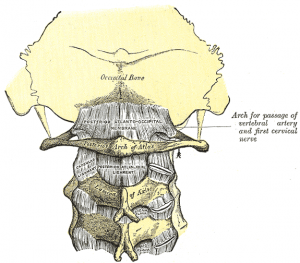Description
The posterior atlantoaxial ligament is a broad, thin membrane attached, above, to the lower border of the posterior arch of the atlas; below, to the upper edges of the lamina of the axis. It is a continuation of the Ligamentum flavum, and is in relation, behind, with the obliqus capitis inferior muscle. [1]It is part of a ligament complex called Altantoaxial Ligament Complex (Axis). These four ligaments extend from the Atlas to the Axis:
Attachments
From lower border of atlantal arch (and more superiorly to the occipital bone) and upper borders of lamina of C2.
Function
It contributes the stabilization of the atlanto-axial joint movement that overall allows 10-15° of flexion/extension and 30° of axial rotation.
Clinical relevance
- – In case of traumatic and non-traumatic atlanto-axial subluxation/dislocation the posterior atlantisaxis ligamente could suffer a rupture. [2]
- Atlantoaxial instability (AAI)
- – Can originate in a congenital conditions, but in adults, it is primarily seen in the setting of acute trauma or degenerative changes due to the inflammatory pannus of rheumatoid arthritis (RA).
- – The ossification of the posterior atlantoaxial membrane that led to the development of cervical myelopathy is rare.
Treatment
There is no record of specific treatment of the Atlantoaxial ligament complex. Hovewer, in case of AAI or rupture, the treatment should include the cervical stabilization management . Check this page about Cervical Instability for further information.
Resources
See also
Anterior Atlantoaxial Ligament
Anterior Atlanto-occipital Ligament
Posterior Atlanto-occipital Ligament Transverse ligament of the atlas
References



